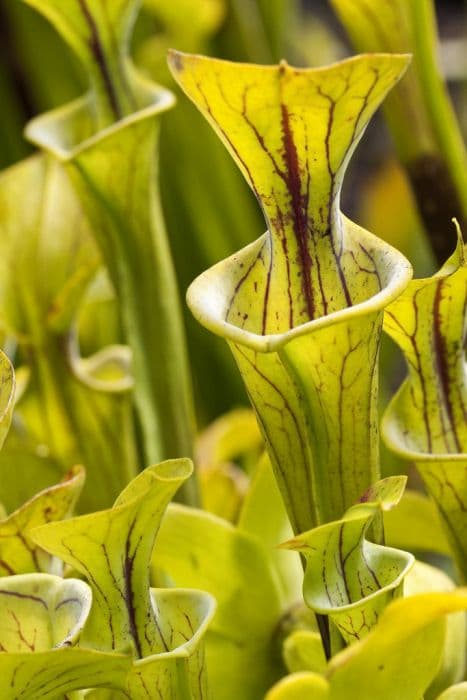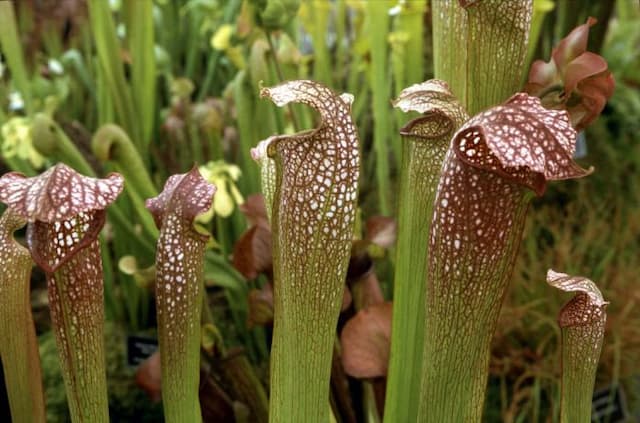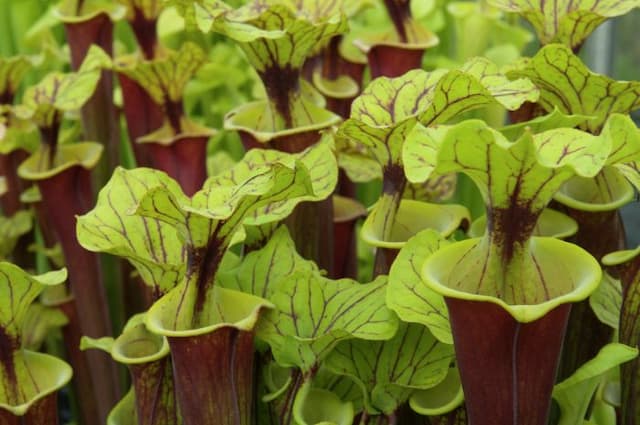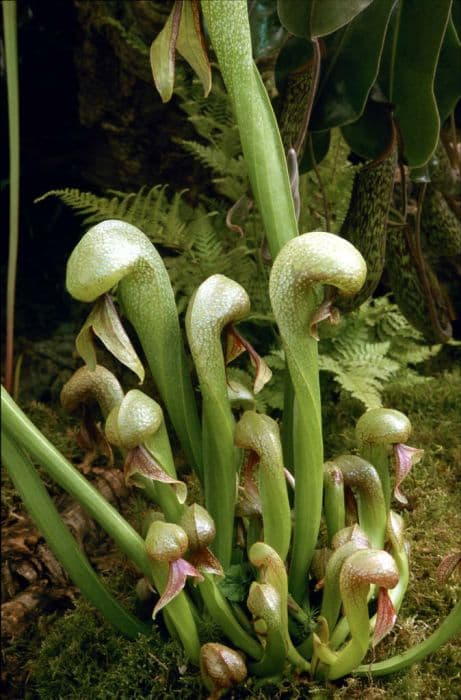Trumpet Pitcher Plant Sarracenia 'Fiona'

ABOUT
The Sarracenia 'Fiona' is a distinctive pitcher plant, notable for its unique leaf structures which are modified into tube-like traps. These pitchers have a striking appearance, with a blend of green and red hues. The pitchers typically feature a colorful gradient, starting with a vibrant green at the base and transitioning to a deep red at the top. This coloring not only adds to its visual appeal but also aids in attracting insects. The mouth of each pitcher is wide and inviting, often adorned with a flared, wavy hood that arches over the opening. This hood protects the inside of the pitcher from excess rainwater while also providing a landing platform for unsuspecting insects. The interior of the pitchers is slick, with downward-pointing hairs, making it difficult for trapped insects to climb out once they have fallen in. Beyond the pitchers, the plant has a rosette of leaves at the base, which are less showy and tend to be a plain green color. The contrast between the vibrant pitcher traps and the basal leaves adds visual interest to the plant's overall appearance. During the blooming season, Sarracenia 'Fiona' may produce flowers on tall stalks that rise above the pitchers, but these flowers are not the primary reason the plant is sought after. The attractive traps of the Sarracenia 'Fiona' give it a dramatic presence, making it a fascinating and often sought-after specimen for enthusiasts of carnivorous plants. Its ability to lure, capture, and digest insects not only serves as a survival mechanism but also provides a unique spectacle that draws interest and admiration.
About this plant
 Names
NamesFamily
Sarraceniaceae.
Synonyms
Fiona Pitcher Plant, Fiona North American Pitcher Plant.
Common names
Sarracenia 'Fiona'.
 Toxicity
ToxicityTo humans
The Sarracenia 'Fiona', commonly known as the pitcher plant, is not generally considered toxic to humans. However, it is always advised to avoid ingesting parts of any ornamental plant, as they can cause stomach upset or other unintended effects due to natural plant compounds. The pitcher plant is primarily a carnivorous plant and uses its pitcher-shaped leaves to trap and digest insects, rather than being harmful to humans.
To pets
The pitcher plant is generally not considered toxic to pets. As with humans, it is a carnivorous plant that attracts and digests insects rather than posing a risk to animals. Nonetheless, it is typically recommended to keep pets from ingesting plants, as they can potentially cause gastrointestinal upset or other issues if consumed.
 Characteristics
CharacteristicsLife cycle
Perennials
Foliage type
Deciduous
Color of leaves
Mixed
Flower color
Varies
Height
1-2 feet (30-60 cm)
Spread
1 foot (30 cm)
Plant type
Herb
Hardiness zones
6
Native area
Southeastern United States
Benefits
 General Benefits
General Benefits- Attracts Pollinators: Sarracenia 'Fiona', commonly known as a type of Pitcher Plant, can attract insects, which are beneficial for pollination in the garden.
- Aesthetic Appeal: The distinctive pitcher-like structure and colorful appearance add visual interest to garden spaces.
- Pest Control: This carnivorous plant can help control pest populations by trapping and digesting insects.
- Conversation Starter: Its unique appearance and insect-eating habits can be a point of interest and discussion among garden visitors.
- Adaptability: Pitcher Plants like Sarracenia 'Fiona' are adaptable to various conditions, although they prefer boggy, acidic soils.
- Low Maintenance: Once established in the right conditions, they require minimal care and are not typically bothered by pests and diseases.
- Educational Interest: They provide an opportunity to observe and teach about unique plant adaptations and ecosystems, especially regarding carnivorous plants.
 Medical Properties
Medical PropertiesThis plant is not used for medical purposes.
 Air-purifying Qualities
Air-purifying QualitiesThis plant is not specifically known for air purifying qualities.
 Other Uses
Other Uses- Sarracenia 'Fiona', commonly known as the pitcher plant, can be used as a natural art subject due to its unique shapes and vibrant colors, providing inspiration for artists and photographers.
- The plant can serve as an educational tool for biology students studying carnivorous plant mechanisms and adaptations in botany classes.
- Being a carnivorous plant, Sarracenia 'Fiona' can be employed as a natural form of pest control, potentially reducing the presence of small insects in the vicinity.
- Its unusual appearance can be used to add an exotic touch to themed gardens or collections that focus on carnivorous or unusual plant species.
- Sarracenia 'Fiona' can be used in ecological studies and conservation efforts to understand the health of bog habitats where these types of plants naturally grow.
- The pitcher plant may be utilized in creative culinary presentations, although it is not edible, as a unique, decorative element on plates at avant-garde restaurants.
- In floristry, Sarracenia 'Fiona' can be a striking addition to floral arrangements, particularly for events that wish to showcase natural diversity or a 'wild' theme.
- It can be used in the design of biomimetic materials, where scientists look to imitate the plant's surface properties for developing non-stick surfaces.
- The pitchers of the Sarracenia 'Fiona' could be investigated by product designers for inspiration in creating new types of liquid or waste traps in industrial designs.
- In the construction of terrariums or vivariums, Sarracenia 'Fiona' can be included as part of a self-sustaining ecosystem that feeds off the insects within the enclosure.
Interesting Facts
 Feng Shui
Feng ShuiThe Pitcher Plant is not used in Feng Shui practice.
 Zodiac Sign Compitability
Zodiac Sign CompitabilityThe Pitcher Plant is not used in astrology practice.
 Plant Symbolism
Plant Symbolism- Uniqueness: Sarracenia, or Pitcher Plant as it is commonly known, has a distinct and unique appearance due to its tubular leaves and pitcher-like shape, symbolizing individuality and standing out from the crowd.
- Attraction and Trapping: The Pitcher Plant lures insects with its nectar and distinctive coloration, symbolizing attraction and the ability to hold onto things, whether it be love, ideas, or opportunities.
- Adaptation: As a carnivorous plant, the Pitcher Plant has adapted to nutrient-poor environments by evolving to digest insects, therefore representing adaptability and resilience in challenging conditions.
- Purification: Pitcher Plants are sometimes considered a symbol of purification because they consume insects, potentially reducing pest populations, paralleling the idea of cleansing or purifying an environment or aspect of life.
 Water
WaterPitcher plants, like Sarracenia 'Fiona', require consistent moisture and should be watered with rainwater, distilled water, or reverse osmosis water due to their sensitivity to minerals in tap water. They thrive in wet environments, so keeping the soil soggy is ideal. This can be done by placing the pot in a tray filled with about 2 inches of water, allowing the plant to draw water from the bottom, and refilling the tray when the water level goes down. During the growing season in spring and summer, water them frequently to maintain the water level in the tray. In winter, reduce watering but ensure the soil remains damp, not dry.
 Light
LightPitcher plants like Sarracenia 'Fiona' require full sun to partial shade for optimal growth. They should be placed in a spot where they can receive at least six hours of direct sunlight daily—preferably morning sun with some afternoon shade. Do not place them in deep shade as this can inhibit their growth and the production of their characteristic pitchers.
 Temperature
TemperatureSarracenia 'Fiona', as a pitcher plant, prefers temperatures ranging from 70°F to 90°F during the growing season. They can survive temperatures as low as 20°F to 40°F during dormancy in the winter, but the ideal growing temperature is between 70°F and 85°F. Ensure that the plant is not exposed to prolonged temperatures above 95°F as this can stress the plant.
 Pruning
PruningSarracenia 'Fiona' benefits from pruning to remove any dead or dying pitchers and flowers, promoting healthier growth and preventing potential disease from decaying plant material. Pruning is best done in late winter or early spring before new growth begins. Cut the dead tissue down to the base of the plant but be careful not to damage new emerging shoots. Pruning can be done annually as needed.
 Cleaning
CleaningAs needed
 Soil
SoilThe pitcher plant Sarracenia 'Fiona' requires a well-draining soil mix typically comprising sphagnum peat moss and perlite in a 1:1 ratio to mimic its natural boggy habitat. Acidic conditions are crucial for optimal growth, so the soil pH should ideally be between 4.0 and 6.0.
 Repotting
RepottingThe pitcher plant Sarracenia 'Fiona' should be repotted every 2-3 years to refresh the soil and prevent compaction. It's best to repot in the early spring just before the growing season begins.
 Humidity & Misting
Humidity & MistingPitcher plants like Sarracenia 'Fiona' thrive in high humidity conditions, generally above 60%. Consistently high humidity helps in maintaining their health and promoting the growth of their characteristic pitchers.
 Suitable locations
Suitable locationsIndoor
Keep pitcher plant 'Fiona' in bright, indirect light and high humidity.
Outdoor
Place pitcher plant 'Fiona' in full sun to partial shade in a bog garden.
Hardiness zone
5-9 USDA
 Life cycle
Life cycleThe Sarracenia 'Fiona,' commonly known as Fiona Pitcher Plant, begins its life cycle as a seed, which after a period of cold stratification, typically germinates in the spring. Seedlings develop into juvenile plants with small, non-carnivorous leaves initially, and as they mature, they produce the characteristic pitcher-shaped carnivorous leaves adept at trapping insects. During the growing season, which is mainly from spring through fall, the plant goes through vegetative growth, focusing on photosynthesis and prey capture for nutrients. The Fiona Pitcher Plant typically flowers in late spring with unique, nodding flowers that are pollinated by insects, leading to the production of seeds ensuring the continuation of the cycle. To survive winter dormancy, the plant slows or stops growth, and older pitchers may die back as the plant conserves energy, re-emerging with new growth in the following spring. Each cycle of growth from seedling to mature plant may take several years, with the plant increasing in size and pitcher quantity with each season.
 Propogation
PropogationPropogation time
Spring-Early Summer
Propogation: The Sarracenia 'Fiona', commonly known as the Pitcher Plant, is best propagated through division, which is often carried out in late winter or early spring before the new growth commences. To propagate by division, carefully take the plant out of its pot and gently separate the rhizome into smaller segments, making sure that each segment has at least one growing point. These segments are then potted into individual containers filled with a suitable carnivorous plant potting mix, typically a blend of peat and perlite or sand. It’s important to keep the newly potted divisions moist and maintain high humidity as they establish. After some time, the divisions will start showing new growth, indicating they have successfully rooted. This method tends to be favored as it is straightforward and maintains the genetic integrity of the cultivar.









